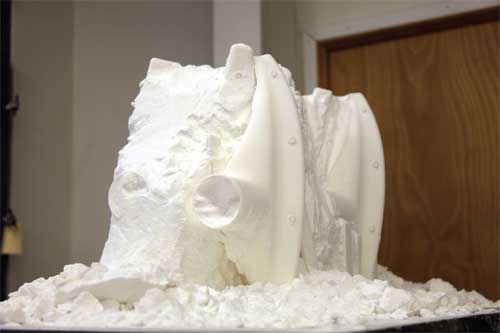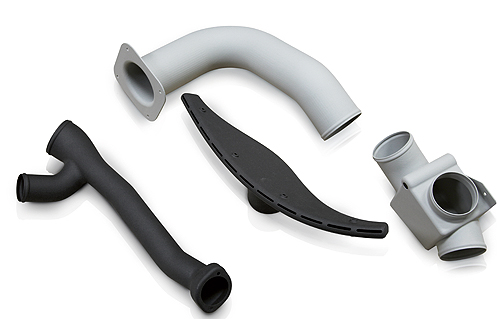Bell Helicopter Textron, Inc. was certainly no stranger to laser sintering when it began to evaluate the process as an option for end-use part manufacturing. For years, Bell Helicopter and its supplier Harvest Technologies have partnered together to produce flight-certified hardware on a standard laser-sintering platform. Bell Helicopter felt it could achieve success with laser sintering because of its extensive experience qualifying both products and manufacturing processes, and Harvest had the expertise in additive manufacturing (AM) that the company was looking for.

The P 730 reduces the amount of partially melted powder generated during a print, increasing the amount of powder that can be recycled.
Selection of the EOSINT P 730 plastic laser-sintering system for manufacturing aircraft parts was a result of study and testing, focusing on technical and financial benefits. The EOSINT P 730 features twin 50-W lasers working in tandem over an expansive build area with a build speed of 35 mm/1.38 in. per hour of height.
With a build platform of 700 x 380 x 580 mm (27.6 x 15 x 23 in.), the system is larger than the laser-sintering systems Harvest had used before. The larger build platform meant the system could produce more components per batch. The P 730 also incorporated a software “fix” for laser sintering that provided crisper detail and smoother surfaces. As a result, there was less peripheral powder melting and adhesion, which increased the amount of powder that could be recycled and reduced post-processing costs.
However, before production could begin, Bell Helicopter and Harvest needed to test the additive machine and its processing capabilities to certify the platform for use. The dual laser system and the subsequent ‘knit line’ presented a new consideration both companies needed to analyze and evaluate. Verifying a new platform meant not only addressing these factors, but also examining other common issues such as heat distribution (part bed temperature consistency), powder degradation, dimensional accuracy, repeatability, part quality, part performance and the overall economics of the platform.
First, Bell Helicopter characterized the materials—a variety of laser-sinterable Nylon 11s and 12s. Once that step was completed, the existing materials characterization and database ensured that the P 730 machine qualification (both the system and its process) was accomplished quickly.

Parts produced on the P 730 have good feature definition, and the powder color consistently exhibits less oxidation.
Bell Helicopter also followed its standard procedure for auditing suppliers, not just for conformation of the Bell Helicopter process specification, but also a quality audit, periodically reviewing Harvest’s QA system with an eye to AS 9100C, the SAE quality management standard for aerospace.
With both the P 730 system and nylon materials qualified, Bell Helicopter and Harvest could begin the meticulous sequence of manufacturing aerospace hardware, which involves many checks and confirmations along the way.
Bell Helicopter is interested in employing laser-sintered parts throughout the aircraft systems of its commercial helicopters. At present, the company is mostly using laser-sintered components in the ECS system. Bell Helicopter will also be evaluating laser sintering of high-temperature plastics intended for use in more demanding roles and environments.
Harvest has acquired a second P 730 system and an EOSINT P 760 system from EOS and is currently working with Bell Helicopter to implement the manufacture of one-off or two-off orders of spares, nested in with its existing batch production.
Harvest Technologies
www.harvest-tech.com
Filed Under: Aerospace + defense, 3D printing • additive • stereolithography, Lasers, MOTION CONTROL, MORE INDUSTRIES





Tell Us What You Think!